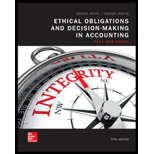
Concept explainers
Identify the objectives of audit risk assessment; its importance in assessing the occurrence of fraud; and the influence of the assessment on evaluation of ICFR.
Explanation of Solution
Risk assessment refers to the estimation of the possibility of the adverse conditions. It may be considered as the analysis of “What is the worst that can happen”. The risk assessment must be carried on based on the ethical tone of the top management, misstatements, frauds and errors. The major objective of risk assessment is to scrutinize the weakest links in the financial reporting controls.
The importance of risk assessment includes the strengthening of the internal control, which reduces the opportunity for fraud. Risk assessment identifies the internal control deficiencies and the sensitive areas of the audit.
The risk assessment enables the auditor to find the material misstatements. This enables the auditor to perform the audit in a more efficient and effective manner.
Want to see more full solutions like this?
Chapter 5 Solutions
Loose Leaf Ethical Obligations And Decision Making In Accounting: Text And Cases
- Accurate Answerarrow_forwardGeneral accountingarrow_forwardSwamy Stationery Inc. budgeted production of 64,000 planners in 2023. Paper is required to produce a planner. Assume 95 square yards of paper are required for each planner. The estimated January 1, 2023, paper inventory is 400,000 square yards. The desired December 31, 2023, paper inventory is 370,000 square yards. If paper costs $0.14 per square yard, determine the direct materials purchases budget for 2023.arrow_forward
- Please provide the correct answer to this general accounting problem using accurate calculations.arrow_forwardAccounting answer pleasearrow_forwardAt the beginning of the year, a company estimates total direct materials costs to be $800,000 and total overhead costs to be $1,000,000. If the company uses direct materials costs as the allocation base for overhead, what is the predetermined overhead rate it should use during the year?arrow_forward

 AccountingAccountingISBN:9781337272094Author:WARREN, Carl S., Reeve, James M., Duchac, Jonathan E.Publisher:Cengage Learning,
AccountingAccountingISBN:9781337272094Author:WARREN, Carl S., Reeve, James M., Duchac, Jonathan E.Publisher:Cengage Learning, Accounting Information SystemsAccountingISBN:9781337619202Author:Hall, James A.Publisher:Cengage Learning,
Accounting Information SystemsAccountingISBN:9781337619202Author:Hall, James A.Publisher:Cengage Learning, Horngren's Cost Accounting: A Managerial Emphasis...AccountingISBN:9780134475585Author:Srikant M. Datar, Madhav V. RajanPublisher:PEARSON
Horngren's Cost Accounting: A Managerial Emphasis...AccountingISBN:9780134475585Author:Srikant M. Datar, Madhav V. RajanPublisher:PEARSON Intermediate AccountingAccountingISBN:9781259722660Author:J. David Spiceland, Mark W. Nelson, Wayne M ThomasPublisher:McGraw-Hill Education
Intermediate AccountingAccountingISBN:9781259722660Author:J. David Spiceland, Mark W. Nelson, Wayne M ThomasPublisher:McGraw-Hill Education Financial and Managerial AccountingAccountingISBN:9781259726705Author:John J Wild, Ken W. Shaw, Barbara Chiappetta Fundamental Accounting PrinciplesPublisher:McGraw-Hill Education
Financial and Managerial AccountingAccountingISBN:9781259726705Author:John J Wild, Ken W. Shaw, Barbara Chiappetta Fundamental Accounting PrinciplesPublisher:McGraw-Hill Education





